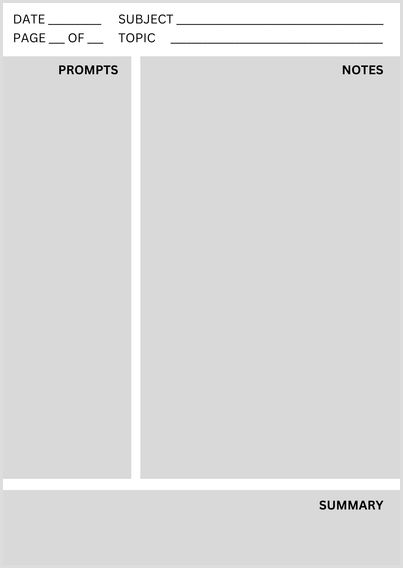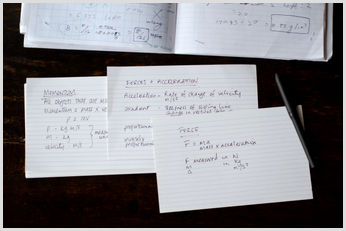It's not easy to make good revision notes - it marks the start of revising a topic and can be painstaking to get going. There's also the awareness that taking too long to write notes is taking time away from revising. The challenge is to make notes that are succinct and well-organised.
This article looks at the best approach to making revision notes, in particular for GCSE and A-Level. This includes the decision to write notes by hand or using a computer, the importance of being concise in note making and how to structure notes using the Cornell system. If you need 1-2-1 support preparing for your exams, you can find a tutor for exam preparation, such as DBS-checked GCSE Maths tutors.
1 - Write notes by hand or device?
Revision is a solitary task. Everyone has their personal preferences to make the process work for them. This includes the decision to write revision notes by hand or type them up using a laptop or similar.
A study by the University of California showed that writing notes by hand is more effective for memory retention. It takes longer to make notes so you're likely to more selective as you write. This extra processing benefits retention. You also won't be distracted by any of the multitudes of diversions a device provides.
That said, writing notes by hand is less effective for certain subjects and programs. Ultimately, it's subjective and the decision is personal to the individual: what works best for you?
Whether you decide to make notes on your laptop or by hand, it's best to stick with this decision so all your notes are in one place. If you decide to use a device, make sure you have a backup. You can do this manually using an external hard drive or store your notes on the cloud so you have one less thing to think about, such as with Google Drive.
2 - Summarise your notes
Summarising is crucial for making good revision notes. You should always avoid writing out revision notes in longhand - you aren't aiming to rewrite the course material again. After all, if you need to clarify a revision note, you still have the textbook, workbook or module guide with full details. Instead, you should look to simplify the text and strip it down to the key facts. This is particularly important when preparing for GCSE exams: you're preparing for over 10 subjects so you need to use your revision time effectively.
When writing up your notes from each subject at school (see later in the article), it's a good idea to make a summary at the end of each lesson. This will ensure you've covered the main points.
Take a look at the example below to see a before-and-after showing how to condense a paragraph. This excerpt is taken from a Wikipedia article about Beethoven:

This is an example of the detailed text you see in a textbook or similar. It's not helpful to write it out again word for word. This will take up too much time and the act of summarising and rewriting the key points will help us remember the topic:

Rewriting text is a useful process not just to improve memory retention. It is also important if you are gathering information to write an essay and you want to avoid plagiarising someone else's work.
3 - Structure notes with the Cornell system
You should try to write your notes in the same succinct, easy-to-read structure. Having a standardised structure will give your notes continuity that will help you with revision, especially when you need to pick up a particular topic at random that you may be struggling with, for example.
The best-recommended structure for revision notes is the Cornell note-taking system. It was created by Walter Pauk in the 1950s who was an education professor at Cornell University.
The Cornell method is broken down into three sections in the template:
- Prompts (top-left) - These are the key points or questions for the revision topic e.g. if the topic is the Stomach, a prompt may be "What is the anatomy of the stomach?"
- Notes (top-right) - These are the main notes linked to the prompt, answering the question or going into detail on a key point e.g. a note for the above prompt could be "Stomach = muscular sac with thick walls. It continues the process of mechanical and chemical digestion."
- Summary (bottom) - This is a summary of this page e.g. "The stomach is made of 3 muscular layers and an outer layer of serosa". Only list the key points in this section.
The Cornell method lets you jump into a topic easily thanks to the summary at the bottom of the page. These summaries act like cue cards, helping to refresh your memory with a quick glance. You can test yourself by covering up the main section of the page and seeing how much you remember the topic.
This is an example of what the Cornell notes template looks like:

4 - Write up notes from class
Before using other revision materials, make sure to write up notes from your school lessons. Your teacher will have covered the key requirements of the syllabus in class. It's a good starting place to go through school notes before looking elsewhere to supplement this knowledge.
As mentioned above, make sure you are concise when writing up these notes. We recommend using the Cornell system.
It's likely that you will occasionally miss details when writing down what your teacher said in lessons. Your notes from class may also be confusing - you may have written down a few keywords quickly while your teacher was talking before the lesson moved on.
In this situation, you can look for answers later. For example, you can ask the teacher, ask a friend or use external revision material (see below). If you're looking through a textbook or similar, use the keywords you've written down as a starting point, such as looking in the glossary.
We recommend separating your school revision notes from those taken with textbooks. You can split these notes into separate folders to keep things clear. The notes from school are the most important: if you have separated the revision notes, you'll be able to pick up the school notes near the exam to test your understanding of the key information.
5 - Write up notes from textbooks
Now that you have written up your school notes, you should move on to take notes from textbooks and study guides. There will be gaps in your knowledge from what you learnt at school. There may have been topics you found more difficult to understand, which need further study. There could also be topics you missed from lessons or that you only wrote down the keywords from. This is where revision guides come in handy - making sure there are no holes in your knowledge.
As we keep stressing, it's important to be concise when writing these notes. This is especially true with notes from textbooks and study guides, which are in addition to existing notes. You want to avoid your revision notes becoming any bigger than they need to be. The exception is if it's a subject you have been struggling with, in which case it makes sense to go into more detail until you fully understand it.
Some of the notes you make may be topics or subtopics that you didn't study in class. For this reason, it's always helpful to rewrite what you've read in your own words. After all, repetition is one of the best ways to remember something: the act of reading and rewriting will ensure you fully understand the topic. This will aid in better retention.
6 - Organise your revision notes
If your revision notes are not all in one place or are a jumbled pile, you will lose time trying to find notes that could otherwise be spent revising. Organising your revision notes, therefore, is a must - it can be a pain, but it will help you in the long run. The time available for revision has a habit of running out quickly and being organised will help you to find the notes you need quickly without added stress and frustration.
At the same time, make sure you aren't too organised. Being overly organised can be a distraction technique, conscious or otherwise, to keep you from revising.
Here are a few suggestions to organise your revision notes:
- Use folders, files and binders for handwritten notes
- Create clearly labelled virtual folders if you are revising on a laptop or other device
- Keep your notes for each subject in one place, such as a physical/virtual folder.
- For handwritten notes, use a binder for each subject. You can then use file dividers to further separate each subject into individual topics.
- Make sure that you back-up virtual folders to avoid any potential catastrophes and added stress.
7 - Be creative and use visual variety
Revision is boring. There's no getting around it. It's also crucial to get the grades you are targeting. The good news is, there are ways to make revision more engaging and remove the tedium. This in turn will help make your revision more effective.
Here are some revision techniques to consider:
- Revision cards - Your revision notes will hopefully already be succinct, especially if you write your notes using the Cornell system. If you want to shrink the notes further, you can make stand-alone flash cards. This is especially useful if you like to be active while revising as you can walk around the room while testing yourself with revision cards.
- Colour - Use highlighters to show key concepts. Using different colours is a good way to further break down important information. For example, one colour could show the most important details and another could be minor "did-you-know" additions. You could also have one colour showing what you understand well and another colour showing what you need more revision on. Just make sure you are sparing in what you highlight - try to avoid highlighting entire paragraphs!
- Layout - Bullet points are a great way to stress the important points. Post-its are also very popular, particularly as their size forces you to be as concise as possible. There's much further that you can go here, such as using graphs, diagrams, tables, spreadsheets and mind maps to break down topics. There's no reason to stick to just one layout. Try a variety of the above and see what helps you most.
- Silly sentences - Funny rhymes and silly sentences are a great way to summarise key content and jog your memory. Mnemonics are a great idea: for example, the mnemonic for remembering the planets in "Many Vicious Elephants Met Just Slightly Under New Pineapples". This sounds bizarre but is a good way to remember Mercury, Venus, Earth, Mars, Jupiter, Saturn, Uranus and Pluto*
* Pluto is no longer considered a planet so this pneumonic needs tweaking!
This post was updated on 09 Jul, 2025.

